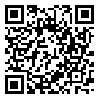Volume 20, Issue 1 (March 2022)
Iranian Rehabilitation Journal 2022, 20(1): 73-80 |
Back to browse issues page
Download citation:
BibTeX | RIS | EndNote | Medlars | ProCite | Reference Manager | RefWorks
Send citation to:



BibTeX | RIS | EndNote | Medlars | ProCite | Reference Manager | RefWorks
Send citation to:
Babaei-Ghazani A, Aflakian N, Fadavi H R, Babashahi A, Azar M, Afshari-Azar F, et al . Pronator Teres Reflex and the Diagnosis of C6 and C7 Radiculopathy. Iranian Rehabilitation Journal 2022; 20 (1) :73-80
URL: http://irj.uswr.ac.ir/article-1-1394-en.html
URL: http://irj.uswr.ac.ir/article-1-1394-en.html
Arash Babaei-Ghazani1 

 , Negar Aflakian1
, Negar Aflakian1 

 , Hamid Reza Fadavi2
, Hamid Reza Fadavi2 

 , Ali Babashahi3
, Ali Babashahi3 

 , Maziar Azar3
, Maziar Azar3 

 , Fariba Afshari-Azar3
, Fariba Afshari-Azar3 

 , Hosnieh Soleymanzadeh1
, Hosnieh Soleymanzadeh1 

 , Mathieu Boudier-Reveret4
, Mathieu Boudier-Reveret4 

 , Bina Eftekharsadat *
, Bina Eftekharsadat * 

 5
5


 , Negar Aflakian1
, Negar Aflakian1 

 , Hamid Reza Fadavi2
, Hamid Reza Fadavi2 

 , Ali Babashahi3
, Ali Babashahi3 

 , Maziar Azar3
, Maziar Azar3 

 , Fariba Afshari-Azar3
, Fariba Afshari-Azar3 

 , Hosnieh Soleymanzadeh1
, Hosnieh Soleymanzadeh1 

 , Mathieu Boudier-Reveret4
, Mathieu Boudier-Reveret4 

 , Bina Eftekharsadat *
, Bina Eftekharsadat * 

 5
5
1- Neuromusculoskeletal Research Center, Department of Physical Medicine and Rehabilitation, Iran University of Medical Sciences, Tehran, Iran.
2- Physical Medicine and Rehabilitation Specialist with Subspecialty in Interventional Pain Management, Clinical Director, Mission Pain and Spine, Mission Viejo, CA, USA.
3- Department of Neurosurgery, School of Medicine, Iran University of Medical Sciences, Tehran, Iran.
4- Department of Physical Medicine and Rehabilitation, University of Montreal Health Centre, Montreal, Canada.
5- Physical Medicine and Rehabilitation Research Center, Department of Physical Medicine and Rehabilitation, Tabriz University of Medical Sciences, Tabriz, Iran.
2- Physical Medicine and Rehabilitation Specialist with Subspecialty in Interventional Pain Management, Clinical Director, Mission Pain and Spine, Mission Viejo, CA, USA.
3- Department of Neurosurgery, School of Medicine, Iran University of Medical Sciences, Tehran, Iran.
4- Department of Physical Medicine and Rehabilitation, University of Montreal Health Centre, Montreal, Canada.
5- Physical Medicine and Rehabilitation Research Center, Department of Physical Medicine and Rehabilitation, Tabriz University of Medical Sciences, Tabriz, Iran.
Abstract: (2050 Views)
Objectives: Neck roots lesions are among the etiologies of cervical and arm pain. A detailed patient evaluation could assist the diagnosis, reduce imaging requests, and promote the treatment of cervical pain. We tried to estimate the value of pronator teres reflex in C6 and C7 roots irritation.
Methods: The present study comprises 118 participants, including 56 patients with C6 and C7 lesions and 62 normal controls. The reliability and usefulness of this reflex in C6 and C7 roots lesions were compared to positive electromyography and imaging with magnetic resonance.
Results: The sensitivity, specificity, positive predictive value, and negative predictive value for pronator teres reflex were 36.4%, 13.6%, 64.8%, and 4.6%, respectively.
Discussion: This reflex can be considered an additional reflex during the physical examination for C6 and C7 nerve roots injury, but its diagnostic value for C6 and C7 radiculopathy is unreliable to be used for screening purposes.
Methods: The present study comprises 118 participants, including 56 patients with C6 and C7 lesions and 62 normal controls. The reliability and usefulness of this reflex in C6 and C7 roots lesions were compared to positive electromyography and imaging with magnetic resonance.
Results: The sensitivity, specificity, positive predictive value, and negative predictive value for pronator teres reflex were 36.4%, 13.6%, 64.8%, and 4.6%, respectively.
Discussion: This reflex can be considered an additional reflex during the physical examination for C6 and C7 nerve roots injury, but its diagnostic value for C6 and C7 radiculopathy is unreliable to be used for screening purposes.
Article type: Original Research Articles |
Subject:
Physical Medicine and Rehabilitation
Received: 2021/06/16 | Accepted: 2022/01/9 | Published: 2022/06/1
Received: 2021/06/16 | Accepted: 2022/01/9 | Published: 2022/06/1
Send email to the article author
| Rights and permissions | |
 |
This work is licensed under a Creative Commons Attribution-NonCommercial 4.0 International License. |





